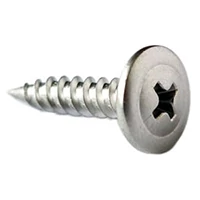truss head self tapping screw
Understanding Truss Head Self-Tapping Screws A Comprehensive Guide
In the vast world of fasteners, truss head self-tapping screws hold a distinct place. Their unique design and functionality make them essential in various applications, from construction to electronics. This article delves into the characteristics, advantages, applications, and installation of truss head self-tapping screws, providing a complete overview for anyone interested in this invaluable tool.
What are Truss Head Self-Tapping Screws?
Truss head self-tapping screws are characterized by their broad, flat head, offering a larger bearing surface and providing excellent support for materials. The head's design allows for efficient torque application, reducing the likelihood of stripping, which is particularly beneficial when fastening soft materials. These screws are equipped with sharp threads and points, enabling them to create their own holes as they are driven into materials, eliminating the need for pre-drilling.
Key Features
1. Truss Head Design The wide, low-profile head provides a stable anchoring point and distributes loads evenly, which is crucial in preventing pull-through. This feature makes them particularly suitable for applications where aesthetics and a flush finish are important.
2. Self-Tapping Mechanism The ability to tap its own hole simplifies the installation process, saving time and reducing labor costs. This feature is particularly valuable in industries where efficiency is a priority.
3. Material and Coating Options Truss head self-tapping screws are available in various materials, including stainless steel, brass, and carbon steel, catering to different environmental conditions and strength requirements. Moreover, they can be coated with materials like zinc or powder for enhanced corrosion resistance.
4. Thread Design The screw features sharp threads that engage with the material as it is driven in. Depending on the type, the threads can be either coarse or fine, with coarse threads providing better grip in softer materials.
Advantages of Truss Head Self-Tapping Screws
1. Ease of Use These screws are straightforward to use, requiring minimal tools. A power drill or manual screwdriver is generally sufficient, making them popular among DIY enthusiasts and professionals alike.
2. Time Efficiency With their self-tapping nature, these screws allow for rapid assembly, significantly reducing project time. This efficiency is particularly evident in industries like woodworking and metal fabrication.
truss head self tapping screw

4. Versatility Truss head self-tapping screws are suitable for a wide range of materials, including wood, metal, plastic, and drywall, making them incredibly versatile for various projects.
Applications
Truss head self-tapping screws find applications in numerous fields, including
- Construction Used for securing structural components, trusses, and roofing materials due to their strong hold and weather resistance. - Furniture Manufacturing Commonly utilized in assembling items where aesthetic appeal is vital, ensuring that the fasteners do not detract from the piece's appearance. - Electronics These screws often serve in mounting electronic components, where precision and reliability are critical. - Automotive Industry They are employed in interior and exterior applications, attaching various components securely while facilitating easy assembly and disassembly.
Installation Tips
To ensure optimal performance when using truss head self-tapping screws, consider the following installation tips
1. Select the Right Size Choosing the appropriate screw length and diameter for the material and application is essential. A screw that is too long may penetrate too deep, while one that is too short may not provide sufficient holding power.
2. Pre-drilling While these screws are designed to tap their own holes, pre-drilling can be beneficial for harder materials. This practice can prevent the material from splitting and ensure a cleaner screw entry.
3. Use the Correct Tool A power drill with a compatible screwdriver bit can provide the needed torque, while manual screwdrivers can help in scenarios requiring precision.
4. Avoid Over-tightening Over-tightening can strip the threads or damage the material being fastened. It's crucial to apply just enough torque to secure the screw without compromising the integrity of the materials.
Conclusion
Truss head self-tapping screws are a vital component in various industries due to their unique design, ease of use, and versatility. Understanding their features and applications can significantly enhance the quality and efficiency of your projects. Whether you are a professional tradesperson or a DIY enthusiast, incorporating truss head self-tapping screws into your toolkit can provide the reliability and strength needed for successful construction and assembly.
-
Top Choices for Plasterboard FixingNewsDec.26,2024
-
The Versatility of Specialty WashersNewsDec.26,2024
-
Secure Your ProjectsNewsDec.26,2024
-
Essential Screws for Chipboard Flooring ProjectsNewsDec.26,2024
-
Choosing the Right Drywall ScrewsNewsDec.26,2024
-
Black Phosphate Screws for Superior PerformanceNewsDec.26,2024
-
The Versatile Choice of Nylon Flat Washers for Your NeedsNewsDec.18,2024










